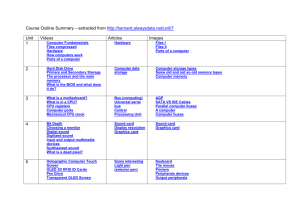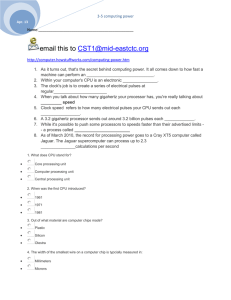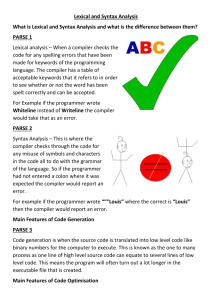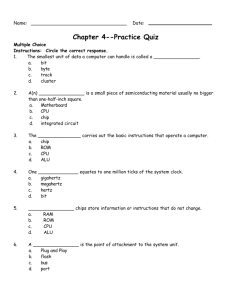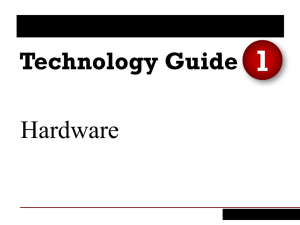Computer Programming Introduction: Hardware, Software, Languages
advertisement
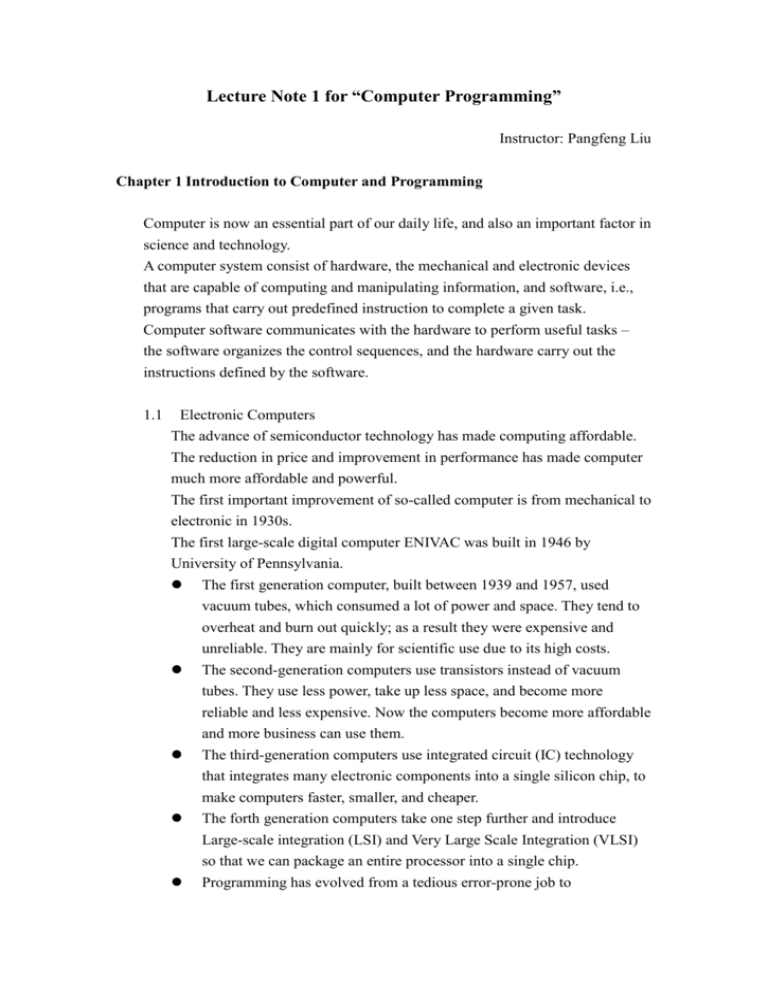
Lecture Note 1 for “Computer Programming” Instructor: Pangfeng Liu Chapter 1 Introduction to Computer and Programming Computer is now an essential part of our daily life, and also an important factor in science and technology. A computer system consist of hardware, the mechanical and electronic devices that are capable of computing and manipulating information, and software, i.e., programs that carry out predefined instruction to complete a given task. Computer software communicates with the hardware to perform useful tasks – the software organizes the control sequences, and the hardware carry out the instructions defined by the software. 1.1 Electronic Computers The advance of semiconductor technology has made computing affordable. The reduction in price and improvement in performance has made computer much more affordable and powerful. The first important improvement of so-called computer is from mechanical to electronic in 1930s. The first large-scale digital computer ENIVAC was built in 1946 by University of Pennsylvania. The first generation computer, built between 1939 and 1957, used vacuum tubes, which consumed a lot of power and space. They tend to overheat and burn out quickly; as a result they were expensive and unreliable. They are mainly for scientific use due to its high costs. The second-generation computers use transistors instead of vacuum tubes. They use less power, take up less space, and become more reliable and less expensive. Now the computers become more affordable and more business can use them. The third-generation computers use integrated circuit (IC) technology that integrates many electronic components into a single silicon chip, to make computers faster, smaller, and cheaper. The forth generation computers take one step further and introduce Large-scale integration (LSI) and Very Large Scale Integration (VLSI) so that we can package an entire processor into a single chip. Programming has evolved from a tedious error-prone job to machine-assisted, semi-automatic process. Computers are classified according to their sizes and speed. They are microcomputer, minicomputers, mainframe computers, and super computers. 1.2 Components of a Computer There are four basic components in a computer system. Central Processing Unit (CPU) The main purpose of CPU is to process data in main memory. CPU is capable of arithmetic and logic operation on data stored in main memory. Main memory The computer software (or program) and the data it wants to manipulate are stored in main memory. The instruction of program are fetched from memory by CPU and executed. The data are also stored in memory to retain their value, or state. Secondary storage The secondary storage provides large, non-volatile, and inexpensive storage for program and data. Input/Output (I/O) devices I/O devices provide channels to transmit/receive data to/from a computer. Memory consists of cells, which are indexed by address. A cell consists of several bytes. Each byte has 8 bits. Memory can be random access memory (RAM) or read-only memory (ROM), or FLASH. RAM can only store data temporarily, i.e. it is a volatile storage device. Secondary storage provides semi-permanent storing capability. Hard disk is the most popular secondary storage devices for its high capacity and low costs. CPU is a complicated chip to handle all the computation within a computer. It has registers and cache memory to store the instruction and data retrieved from main memory, and complicated decoding circuit to determine what action should be performed, and an ALU (arithmetic and logic unit) with circuit to carry out the actual computation. 1.3 Overview of Programming Languages A program is a sequence of well-defined instructions to be carried out by computer hardware. Software can be classified into two categories – system software and application software. System software prepares a computer to be use by a user, e.g., operating system, compiler, editor, etc. Application software performs a particular task for the user, e.g., Microsoft Office, Winamp, Tomb Raider, etc. A high level language lets you write high level construct to express abstract ideas, instead of low-level machine instructions. However, computer hardware can only understand machine language, therefore a high-level construct to low-level machine language translator, or compiler, is needed. A high level language can address memory cell by names, rather than address. Different types of programming language Fortran -- Formula Translation, mainly for scientific and engineering 1.4 people. C/C++ -- System software. Pascal -- Mainly for teaching purposes. COBOL -- Mainly for business and banking purposes. ADA -- Military related control programs with high software reliability. Preparing a Program for Processing and Execution step 1. First use an editor to enter the program and save it as a file. Usually we can the file with program a ‘source file’. step 2. Then compile your source code with a compiler. If there is any syntax error, make the correction and go back to step 1. If there is no syntax problem, the compiler will generate an object file, which contain the machine instructions translated from your source program. step 3. Your program may contain several source files and a linker program is required to ‘link’ all of your object files from individual source program, into an executable file. Most of these compiling and linking operations can be done in a single command line, i.e., step 2 and 3 are usually combined. step 4. If all goes well, you can run the executable to check for the answers. If the answer is not what you want, you have a logic error in your program. Make the necessary corrections and go back to step 1. 1.5 Using a Computer Consult the TA if you have any questions in using a PC, or the Fortran 77 compiler in this class.


